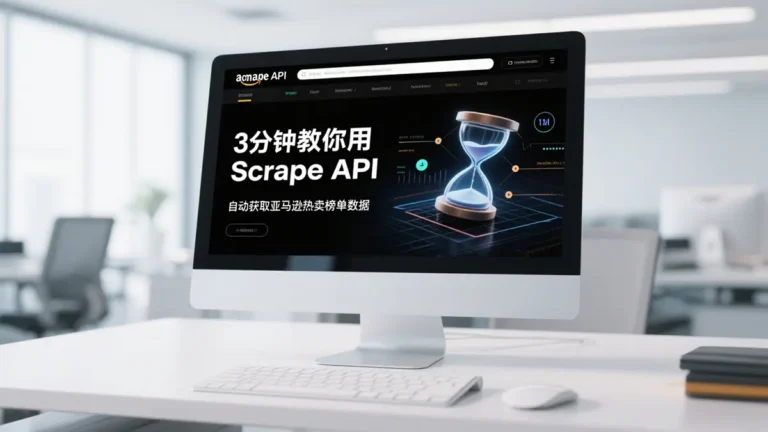In the highly competitive e-commerce landscape, the Amazon Best Sellers API has become an indispensable tool for merchants and data analysts. With a professional Amazon data scraping API, you can easily obtain real-time information on top-selling products, providing powerful data support for product selection, competitor analysis, and marketing strategy development. This article will detail how to use the Scrape API to scrape best-selling product data, allowing you to master this core skill in just 3 minutes.
Why Choose an API to Get Amazon Best Seller Data?
Pain Points of Traditional Data Acquisition Methods
Many e-commerce professionals face numerous challenges when trying to obtain Amazon’s best seller data:
- Inefficient Manual Copying: Copying and pasting product information one by one is time-consuming and prone to errors.
- Frequent Web Structure Changes: Amazon often adjusts its page layouts, causing web scrapers to fail.
- Strict Anti-Scraping Mechanisms: Technical barriers like IP bans and CAPTCHAs are common.
- Inconsistent Data Formats: Data gathered manually is difficult to process and analyze in bulk.
Core Advantages of the API Method
Using a professional Amazon Best Sellers API perfectly solves the problems mentioned above:
1. Efficient and Stable Data Acquisition
- Intelligently adapts to page structure changes, so you don’t have to worry about website updates.
- A distributed architecture ensures 99.9% availability.
- Supports a large volume of concurrent requests, capable of processing thousands of products in a single batch.
2. Structured Data Output
- Directly returns standardized data in JSON format.
- Includes complete product information such as ASIN, title, price, rating, and more.
- Supports multiple output formats (JSON, Markdown, HTML).
3. Advanced Anti-Scraping Technology
- Built-in IP rotation and header spoofing.
- Simulates real user behavior to reduce the risk of being blocked.
- Continuously maintained by a professional team to ensure long-term stability.
Scrape API Product Introduction
Core Features
Scrape API is a professional, automated solution for fetching e-commerce ranking lists, equipped with the following core capabilities:
Supported E-commerce Platforms
- Amazon (US, UK, Germany, France, and other sites)
- Walmart
- Shopify
- Shopee
- eBay
Data Scraping Scope
- Product Detail Pages
- Best Sellers Lists
- New Releases Lists
- Keyword Search Results
- Seller Storefront Product Lists
- Product Category Lists
Technical Advantages
- Synchronous and asynchronous calling methods.
- Supports localized data scraping by postal code.
- Intelligent parsing algorithms automatically adapt to page changes.
- Provides both raw HTML and structured data formats.
Pricing Strategy
We use a flexible, credit-based billing model depending on the data format:
- Markdown Format: 0.75 credits/request
- Raw HTML: 0.75 credits/request
- Structured JSON: 1 credit/request
Quick Start: Fetching Amazon Best Seller Data
Step 1: Account Authentication
Before using the Amazon data scraping API, you need to authenticate to obtain an access token.
Bash
curl -X POST http://scrapeapi.pangolinfo.com/api/v1/auth \
-H 'Content-Type: application/json' \
-d '{
"email": "[email protected]",
"password": "your-password"
}'
Example Response:
JSON
{
"code": 0,
"subCode": null,
"message": "ok",
"data": "eyJhbGciOiJIUzI1NiIsInR5cCI6IkpXVCJ9..."
}
After successful authentication, please save the returned token securely. All subsequent API calls will require this token.
Step 2: Build a Best Sellers Request
Use the amzBestSellers parser to get Amazon Best Sellers data. Here is a complete request example:
Bash
curl -X POST http://scrapeapi.pangolinfo.com/api/v1 \
-H 'Content-Type: application/json' \
-H 'Authorization: Bearer YOUR_TOKEN_HERE' \
-d '{
"url": "https://www.amazon.com/gp/bestsellers/electronics/172282/ref=zg_bs_nav_electronics_2_541966",
"parserName": "amzBestSellers",
"formats": ["json"],
"bizContext": {
"zipcode": "10041"
},
"timeout": 30000
}'
Parameter Details:
url: The target Amazon Best Sellers page link.parserName: Use theamzBestSellersparser.formats: Choosejsonto receive structured data.bizContext.zipcode: A required parameter for localized data acquisition.timeout: Request timeout in milliseconds.
Step 3: Process the Response Data
API Response Format:
JSON
{
"code": 0,
"subCode": null,
"message": "ok",
"data": {
"json": [
"{
\"rank\": 1,
\"asin\": \"B08N5WRWNW\",
\"title\": \"Echo Dot (4th Gen) | Smart speaker with Alexa\",
\"price\": \"$49.99\",
\"star\": \"4.7\",
\"rating\": \"547,392\",
\"image\": \"https://images-na.ssl-images-amazon.com/images/I/61lw7tTzCqL._AC_SL1000_.jpg\"
}"
],
"url": "https://www.amazon.com/gp/bestsellers/electronics/..."
}
}
Data Field Descriptions:
rank: Best-selling rank.asin: Amazon Standard Identification Number.title: Product title.price: Product price.star: Product star rating.rating: Number of reviews.image: Main product image link.
Advanced Features: Batch Processing and Asynchronous Calls
Batch Fetching for Multiple Lists
For scenarios requiring data from multiple best-seller categories, you can use the batch endpoint:
Bash
curl -X POST http://scrapeapi.pangolinfo.com/api/v1/batch \
-H 'Content-Type: application/json' \
-H 'Authorization: Bearer YOUR_TOKEN_HERE' \
-d '{
"urls": [
"https://www.amazon.com/gp/bestsellers/electronics/",
"https://www.amazon.com/gp/bestsellers/home-garden/",
"https://www.amazon.com/gp/bestsellers/sports-and-outdoors/"
],
"formats": ["markdown"],
"timeout": 60000
}'
Asynchronous Processing for Large-Scale Data
For large-scale scraping needs, using the asynchronous API is recommended:
Bash
curl -X POST https://extapi.pangolinfo.com/api/v1 \
-H 'Content-Type: application/json' \
-H 'Authorization: Bearer YOUR_TOKEN_HERE' \
-d '{
"url": "https://www.amazon.com/gp/bestsellers/electronics/",
"callbackUrl": "https://your-domain.com/webhook/amazon-data",
"bizKey": "bestSellers",
"zipcode": "10041"
}'
The asynchronous call will return a task ID. Once the data is processed, the result will be sent to your specified callbackUrl.
Practical Case Study: Building a Best Seller Monitoring System
Business Scenario
A cross-border e-commerce company needs to monitor the real-time performance of its competitors across various Amazon categories to promptly adjust its product and pricing strategies.
Technical Architecture
Python
import requests
import json
import time
from datetime import datetime
class AmazonBestSellersMonitor:
def __init__(self, api_token):
self.api_token = api_token
self.base_url = "http://scrapeapi.pangolinfo.com/api/v1"
self.headers = {
'Content-Type': 'application/json',
'Authorization': f'Bearer {self.api_token}'
}
def get_bestsellers(self, category_url, zipcode="10041"):
"""Fetches best-selling product data for a specific category."""
payload = {
"url": category_url,
"parserName": "amzBestSellers",
"formats": ["json"],
"bizContext": {
"zipcode": zipcode
},
"timeout": 30000
}
try:
response = requests.post(self.base_url,
headers=self.headers,
json=payload)
if response.status_code == 200:
result = response.json()
if result['code'] == 0:
# The JSON data is returned as a string within an array
return json.loads(result['data']['json'][0])
else:
print(f"API Error: {result['message']}")
return None
else:
print(f"HTTP Error: {response.status_code}")
return None
except Exception as e:
print(f"Request Error: {str(e)}")
return None
def monitor_categories(self, categories):
"""Monitors best seller data for multiple categories."""
results = {}
for category_name, category_url in categories.items():
print(f"Scraping {category_name} best seller data...")
data = self.get_bestsellers(category_url)
if data:
results[category_name] = {
'timestamp': datetime.now().isoformat(),
'products': data
}
print(f"Successfully retrieved {len(data)} product(s)")
else:
print(f"Failed to retrieve data for {category_name}")
# Avoid making requests too frequently
time.sleep(2)
return results
def analyze_price_trends(self, historical_data):
"""Analyzes price trends from historical data."""
trends = {}
for category, records in historical_data.items():
category_trends = {}
for record in records:
for product in record['products']:
asin = product['asin']
price = float(product['price'].replace('$', '').replace(',', ''))
if asin not in category_trends:
category_trends[asin] = {
'title': product['title'],
'prices': [],
'ranks': []
}
category_trends[asin]['prices'].append(price)
category_trends[asin]['ranks'].append(int(product['rank']))
trends[category] = category_trends
return trends
# Example Usage
if __name__ == "__main__":
# Initialize the monitor
monitor = AmazonBestSellersMonitor("YOUR_API_TOKEN_HERE")
# Define categories to monitor
categories = {
"Electronics": "https://www.amazon.com/gp/bestsellers/electronics/",
"Home & Garden": "https://www.amazon.com/gp/bestsellers/home-garden/",
"Sports & Outdoors": "https://www.amazon.com/gp/bestsellers/sports-and-outdoors/"
}
# Execute monitoring
results = monitor.monitor_categories(categories)
# Save the results
with open(f'bestsellers_{datetime.now().strftime("%Y%m%d_%H%M%S")}.json', 'w', encoding='utf-8') as f:
json.dump(results, f, indent=2, ensure_ascii=False)
print("Data scraping complete. Results have been saved to a file.")
Key Feature Analysis
- Intelligent Retry Mechanism: The code includes robust error handling logic to automatically retry in case of network fluctuations or temporary failures.
- Data Standardization: It converts price strings into numerical types, facilitating subsequent data analysis and comparison.
- Historical Data Comparison: By saving historical data, you can analyze trends in product rankings and prices over time.
Data Acquisition Strategies for Different Marketplaces
US Site Configuration
JSON
{
"url": "https://www.amazon.com/gp/bestsellers/electronics/",
"bizContext": {
"zipcode": "10041"
}
}
Supported Zip Codes for the US Site:
- New York Area:
10041 - Los Angeles Area:
90001 - Chicago Area:
60601 - Salt Lake City Area:
84104
UK Site Configuration
JSON
{
"url": "https://www.amazon.co.uk/gp/bestsellers/electronics/",
"bizContext": {
"zipcode": "W1S 3AS"
}
}
Supported Postal Codes for the UK Site:
- Central London:
W1S 3AS - Edinburgh:
EH15 1LR - Manchester:
M13 9PL,M2 5BQ
German Site Configuration
For using the Amazon Best Sellers API on the German site:
JSON
{
"url": "https://www.amazon.de/gp/bestsellers/electronics/",
"bizContext": {
"zipcode": "80331"
}
}
Supported Postal Codes for the German Site:
- Munich:
80331 - Berlin:
10115 - Hamburg:
20095 - Frankfurt:
60306
Data Quality Assurance and Best Practices
API Call Frequency Control
To ensure the stability of the Amazon Best Sellers API, we recommend following these rate limits:
- Recommended Interval:
- Individual Product Details: No more than 5 requests per second.
- List Pages: No more than 10 requests per minute.
- Batch Endpoint: No more than 50 URLs per request.
- Error Handling Strategy:
<!– end list –>
Python
import time
import random
def safe_api_call(api_function, max_retries=3):
"""A safe API call wrapper with a retry mechanism."""
for attempt in range(max_retries):
try:
result = api_function()
if result:
return result
except Exception as e:
if attempt < max_retries - 1:
# Exponential backoff strategy
wait_time = (2 ** attempt) + random.uniform(0, 1)
time.sleep(wait_time)
continue
else:
raise e
return None
Data Cleaning and Validation
After fetching the data, it’s advisable to perform data cleaning:
Python
import re
def clean_product_data(raw_data):
"""Cleans and validates product data."""
cleaned_data = []
for product in raw_data:
# Validate required fields
required_fields = ['asin', 'title', 'price', 'rank']
if not all(field in product for field in required_fields):
continue
# Clean price data
if 'price' in product:
price_str = product['price']
# Remove currency symbols and thousand separators
clean_price = re.sub(r'[^\d.]', '', price_str)
try:
product['price_numeric'] = float(clean_price)
except ValueError:
product['price_numeric'] = 0.0
# Validate ASIN format
if 'asin' in product:
asin = product['asin']
if not re.match(r'^[A-Z0-9]{10}$', asin):
continue
# Clean rating data
if 'rating' in product:
rating_str = str(product['rating'])
clean_rating = re.sub(r'[^\d]', '', rating_str)
try:
product['rating_numeric'] = int(clean_rating)
except ValueError:
product['rating_numeric'] = 0
cleaned_data.append(product)
return cleaned_data
Data Storage and Management
For large-scale projects, using a professional data storage solution is recommended:
Python
import sqlite3
from datetime import datetime
class BestSellersDatabase:
def __init__(self, db_path="bestsellers.db"):
self.db_path = db_path
self.init_database()
def init_database(self):
"""Initializes the database table structure."""
conn = sqlite3.connect(self.db_path)
cursor = conn.cursor()
# Create products table
cursor.execute('''
CREATE TABLE IF NOT EXISTS products (
id INTEGER PRIMARY KEY AUTOINCREMENT,
asin TEXT NOT NULL,
title TEXT,
price REAL,
star REAL,
rating INTEGER,
rank INTEGER,
category TEXT,
image_url TEXT,
collected_at TIMESTAMP DEFAULT CURRENT_TIMESTAMP,
UNIQUE(asin, collected_at, category)
)
''')
# Create indexes to improve query performance
cursor.execute('CREATE INDEX IF NOT EXISTS idx_asin ON products(asin)')
cursor.execute('CREATE INDEX IF NOT EXISTS idx_category ON products(category)')
cursor.execute('CREATE INDEX IF NOT EXISTS idx_collected_at ON products(collected_at)')
conn.commit()
conn.close()
def save_products(self, products, category):
"""Saves product data to the database."""
conn = sqlite3.connect(self.db_path)
cursor = conn.cursor()
for product in products:
try:
cursor.execute('''
INSERT OR IGNORE INTO products
(asin, title, price, star, rating, rank, category, image_url)
VALUES (?, ?, ?, ?, ?, ?, ?, ?)
''', (
product.get('asin'),
product.get('title'),
product.get('price_numeric', 0),
float(product.get('star', 0)),
product.get('rating_numeric', 0),
int(product.get('rank', 0)),
category,
product.get('image')
))
except Exception as e:
print(f"Failed to save product data: {e}")
continue
conn.commit()
conn.close()
Cost Optimization and Performance Improvement
Smart Caching Strategy
For the Amazon data scraping API, a sensible caching strategy can significantly reduce costs:
Python
import redis
import json
from datetime import timedelta
class APICache:
def __init__(self, redis_host='localhost', redis_port=6379):
self.redis_client = redis.Redis(host=redis_host, port=redis_port, decode_responses=True)
def get_cached_data(self, url):
"""Gets cached data."""
cache_key = f"bestsellers:{hash(url)}"
cached_data = self.redis_client.get(cache_key)
if cached_data:
return json.loads(cached_data)
return None
def cache_data(self, url, data, cache_minutes=60):
"""Caches data."""
cache_key = f"bestsellers:{hash(url)}"
self.redis_client.setex(
cache_key,
timedelta(minutes=cache_minutes),
json.dumps(data)
)
def get_or_fetch(self, url, fetch_function, cache_minutes=60):
"""Gets cached data or fetches it if not present."""
cached_data = self.get_cached_data(url)
if cached_data:
print("Serving from cache.")
return cached_data
print("Fetching fresh data.")
fresh_data = fetch_function(url)
if fresh_data:
self.cache_data(url, fresh_data, cache_minutes)
return fresh_data
Concurrent Processing Optimization
Using asynchronous programming can dramatically improve scraping efficiency:
Python
import asyncio
import aiohttp
import json
class AsyncBestSellersCollector:
def __init__(self, api_token, max_concurrent=5):
self.api_token = api_token
self.base_url = "http://scrapeapi.pangolinfo.com/api/v1"
self.semaphore = asyncio.Semaphore(max_concurrent)
async def fetch_bestsellers(self, session, url, zipcode="10041"):
"""Asynchronously fetches best seller data."""
async with self.semaphore:
payload = {
"url": url,
"parserName": "amzBestSellers",
"formats": ["json"],
"bizContext": {"zipcode": zipcode},
"timeout": 30000
}
headers = {
'Content-Type': 'application/json',
'Authorization': f'Bearer {self.api_token}'
}
try:
async with session.post(self.base_url, json=payload, headers=headers) as response:
result = await response.json()
if result['code'] == 0:
return {
'url': url,
'data': json.loads(result['data']['json'][0]),
'success': True
}
else:
return {'url': url, 'error': result['message'], 'success': False}
except Exception as e:
return {'url': url, 'error': str(e), 'success': False}
async def collect_multiple_categories(self, category_urls):
"""Concurrently scrapes data from multiple categories."""
async with aiohttp.ClientSession() as session:
tasks = [self.fetch_bestsellers(session, url) for url in category_urls.values()]
results_list = await asyncio.gather(*tasks)
results = {}
for i, category_name in enumerate(category_urls.keys()):
results[category_name] = results_list[i]
return results
# Example Usage
async def main():
collector = AsyncBestSellersCollector("YOUR_API_TOKEN", max_concurrent=3)
categories = {
"Electronics": "https://www.amazon.com/gp/bestsellers/electronics/",
"Home & Garden": "https://www.amazon.com/gp/bestsellers/home-garden/",
"Sports & Outdoors": "https://www.amazon.com/gp/bestsellers/sports-and-outdoors/",
"Fashion": "https://www.amazon.com/gp/bestsellers/fashion/",
"Beauty": "https://www.amazon.com/gp/bestsellers/beauty/"
}
results = await collector.collect_multiple_categories(categories)
# Process results
for category, result in results.items():
if result['success']:
print(f"{category}: Successfully retrieved {len(result['data'])} products.")
else:
print(f"{category}: Failed - {result['error']}")
# To run the async task
# if __name__ == "__main__":
# asyncio.run(main())
Frequently Asked Questions (FAQ) and Solutions
Question 1: API request fails or times out.
- Analysis: Unstable network connection, slow response from the target page, or incorrect request parameters.
- Solution: Implement a robust calling function with retries and exponential backoff.
Question 2: Data parsing error.
- Analysis: The page structure has changed, the parser version is outdated, or there’s an issue with special character handling.
- Solution: Implement data validation checks to ensure data integrity before processing.
Question 3: IP is blocked or access is restricted.
- Analysis: Request frequency is too high, appropriate headers are not used, or there are geographical restrictions.
- Solution: This is effectively avoided by using Scrape API’s distributed proxy pool, which automatically handles IP rotation and anti-scraping strategies.
Conclusion and Future Outlook
Through this detailed guide, you have now mastered the complete process of using the Amazon Best Sellers API for data scraping. From basic API calls to advanced concurrent processing and data management, this solution can meet a wide range of needs, from small-scale monitoring to large-scale data analysis projects.
Core Advantages Revisited:
- Efficient and Stable: Intelligently adapts to page changes, ensuring long-term availability.
- Rich Data: Includes complete product information like rank, price, and ratings.
- Easy to Use: Standard RESTful API, compatible with multiple programming languages.
- Controllable Costs: Flexible credit-based billing for pay-as-you-go usage.
- Technologically Advanced: Supports synchronous and asynchronous calls for different scenarios.
As the e-commerce market evolves, automated list scraping will become a core competency for e-commerce professionals. Scrape API, as a professional Amazon data scraping solution, not only helps you quickly obtain best-selling product data but also provides powerful data support for your business decisions.
Future Trends:
- AI-Driven Data Analysis: Combine scraped data with machine learning algorithms for sales trend forecasting, price volatility analysis, competitor strategy identification, and market opportunity discovery.
- Real-Time Data Stream Processing: Build real-time product monitoring systems using webhooks and stream processing technologies.
- Multi-Platform Data Integration: Create a panoramic market view by integrating data from multiple platforms like Amazon, Walmart, and eBay.
The practical applications are vast, from building product selection assistants and dynamic pricing systems to generating visual analytics reports and integrating with enterprise-level ERP systems.
The Amazon data scraping API is more than just a data acquisition tool; it is a strategic weapon for gaining an advantage in the fierce e-commerce competition. Start using Scrape API today and let data power your business growth!
To learn more, please visit: www.pangolinfo.com
This is an original technical article detailing how to use a professional API tool to obtain Amazon Best Sellers data. All code examples provided are ready to use to help you quickly build your own data acquisition system.



